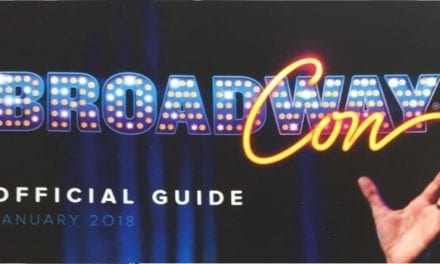It’s UTBA’s fifth anniversary. Five years ago the web site went live, and we started the monumental task of chronicling as much live theatre as we could in this state. It’s not an easy process. To give our readers a sneak peak behind the scenes at UTBA, here are the steps I use to writing a play review—UTBA style!
Step 1: Learn about the play
The first step in writing a review is preparation, which may start 5 minutes before curtain or a few weeks before. The type and amount of preparation varies from show to show. Some plays require very little preparation from a reviewer, especially if the reviewer has seen the play multiple times. For me, that would be plays like Les Misérables, A Midsummer Night’s Dream, or The Music Man because I have seen all of those plays so many times that I have lost track. I am also less likely to spend a great deal of preparation for a non-Equity production.
For a lesser known play (like ‘Tis Pity She’s a Whore or Cato) or a play I have never seen before (like Hecuba or Once on This Island) I often research the play, the playwright’s life, or the genre of the show. For an adaptation, some reviewers explore the original source material (e.g., a novel, film) that the play is based on. If a review is important (and my day job gives me enough time to permit it), then I may even read the script (like for Measure for Measure) or watch a film version of the play.
The last step of preparation is to ensure I have the materials I need to properly review the play. That means I bring a few pens and a notebook with me to the theater. Every professional reviewer I know takes notes as they watch a play, and it is impossible to write a useful play review solely from memory. Finally, I make sure that I get a playbill, which is often a useful aid for writing a review, as it has the correct spelling of actors’ and characters’ names and other useful information, like song titles.
Step 2: Pay attention and take notes

The author’s notes for Brigham Young University’s production of Our Town, which he reviewed in November 2014.
Taking notes is the most important aspect of reviewing a play. I have posted a picture (to the right) of a typical page of notes I take during a play. I usually divide my paper into four sections: directing, acting, visual/technical, script/other. (I have slightly different section names for musicals.) Dividing my page into sections before the play starts makes it easy to write in the dark and to find notes about the same topic afterwards. Other reviewers prefer to have a legal pad or notebook and to write everything in the order it pops into their head.
During the play, I write down everything I notice about the play or my response to it. For example, in the example at right (which was for BYU’s recent production of Our Town), I have notes that say:
- “Multimedia from the beginning – removes some of the imagination of the show.”
- “Perfect interactions w/film and stage.” This line has a smaller note saying “professor & SM” with an arrow connecting the two.
- “Sweet mood lighting @ night – relaxing – blues & tree gobos.”
- “George so fun in his boyish infatuation w/Emily.” This is connected with an arrow to another note saying, “reminds me of a young Jimmy Stewart.”
- “good contrast b/w film & stage acting.”
- “sibling rivalry, rush in getting ready for school.”
Obviously, there are a lot of abbreviations and thoughts that I jot down in a hurry. Full sentences, penmanship, and grammar go out the window as I take notes on a play. This is because fast note taking means I can spend more time paying attention to the play. I hate it when I miss a joke or an important action because I was busy writing something down.
Step 3: Go home and organize those notes!
It should be clear that the disorganized notes I scribble in the dark are not a play review. However, they provide me the information I need to write the review. The first thing I do when I get home is re-read my notes and decide what thoughts will make it into the review and which ones will be left out. Most reviewers write down far more than what they can discuss in a coherent review, so I need to decide what will make the cut and what won’t. I also try to find phrases that I wrote down or common themes among my notes in order to find the main idea of my review.
Step 4: Write the review
After organizing my notes (and thoughts!) it is time to write the review. For the Our Town review, the comment I wrote down about one actor reminding me of “a young Jimmy Stewart” made it into the review. So did the comment about the siblings’ interactions. Other comments, like the “sweet mood lighting” didn’t contribute to the final review.
For most plays UTBA policy requires reviewers to discuss at least one technical element, one actor, and the directing. But the rest of the review content is up to the reviewer. After I have mentioned every important aspect to the production, I write the introductory and concluding paragraphs. The first paragraph should prepare the reader for the rest of the review, while the last paragraph should provide an overall summary of the reviewer’s opinion.
Step 5: Submit and edit
The last step to writing a review at UTBA is to submit and edit it. Everyone at UTBA gets edited. During this process, the editor corrects typos and grammar, adds links to related reviews in our archive, uploads publicity photos and art, may rework a sentence, change (or write) a title for the review and sometimes reduce the length of the review. They also make sure that the reviews adhere to UTBA’s publication standards. Most changes are minor, however, and reviewers can ask for a reversal of any change that they don’t agree with. When the reviewer is done with making these changes, they then publish the review.
These are the 5 steps to writing a play review. But don’t be deceived. Creating a play review is not a mechanical process. It also takes creativity and the ability to write quickly, often late into the night before going to bed. But it is a worthwhile endeavor that benefits audience members, actors, designers, and the entire theatre community. Repeat the process over 1,050 times, and in five years you have a massive archive of live theatre productions.





